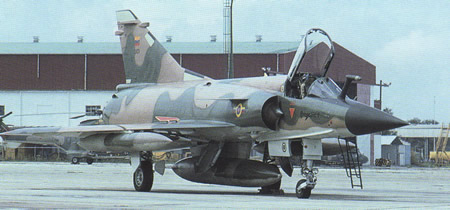|
Venezuela’s 1992 coup attempt
by Raul Colon
June 6th 2009
Email:rcolonfrias@yahoo.com

F 16 at El
Libertador Air Force Base
If compared to the rest its South American counterparts,
Venezuela enjoyed a relative stable form of government for
much of the 1970s and 80s. As with the rest of the country’s
military arms, the Fuerza Aerea Venezolana (FAV) suffered
from a prolonged period of budgetary restrictions and
limitations that started in the mid 70s and lasted until the
early mid-to late 80s. This period of stagnation left the
once powerful FAV in a state of flux. During that time, most
of the FAV assets became non-operational. But by 1987, the
situation was commencing to improve with the acquisition by
the Venezuelan government of top shelf equipment such as
powerful USA built F-16A Falcon. The FAV also began a crash
program to upgrade its Mirage units to 2000’s standards.
On February 24th,
1992, the paratroop units of Grupo Paracaidista Aragua, led
by Lieutenant Colonel, and current president of the
republic, Hugo Chavez; staged a coup attempt. Although the
coup was quickly squashed, feelings inside the air force
remained high and volatile. So much so that on the 27th
of November, a further attempt to rest power from the
civilian government was made. Lead by the charismatic
Brigadier General Francisco Visconti, lead elements of the
FAV used the Air Force Day preparations to move units into
the El Libertador Air Force Base at Palo Negro, Aragua.
The units included a sole
NF-5B, five T-2Ds, six OV-10As, three OV-10Es and two A-27s.
At 0330 on the morning of the 27th, Visconti’s
forces seized the control of the important base. Supported
by the well respected 10th Special Operations
Group, which operated most of the air force’s helicopter
fleet, and the Grupo de Caza 11, Visconti’s men met little
opposition. But this did not mean that all base personnel
were supporting with the coup. Two QRA aircraft from Grupo
de Caza 16, managed to escape to Barquisimeto. A base that
remained loyal to the republic’s president. The rest of Caza
16’s assets were captured. While the El Libertador operation
was underway, supplemental units of the 10th were
capturing the near by Mariscal Sucre air force base at Boca
Del Rio, Maracay. Mariscal Sucre was the home of the FAV’s
training fleet of EMB-312 Tucanos and T-34As trainers.
That same morning in Caracas,
three French-built Mirage 50EVs from Grupo 11 began strafing
the Army’s barracks. Another force composed of Broncos,
Tucanos and Buckeyes; attacked the presidential palace, the
foreign ministry building, the police headquarters and the
Presidential Guard barracks. Unlike previous attacks on El
Libertador and Sucre, this time the attacking force met
resistance. Suddenly and almost out of nowhere, the two F-16
Falcons that escaped Libertador appeared over the skies of
the Venezuelan capital. It did not take long before the
modern Falcons chased away the Tucanos and Broncos. Then,
the heavily armed F-16s moved to Sucre and Libertador
strafing anything that moved on the ground with their
powerful 20mm cannons.
Also in the morning of the 27th,
and while forces loyal to the government started to
counterattack the rebel positions, insurgence Mirages and
Broncos took off from Sucre to commence their attacks on
Barquisimeto. There they proceeded to destroy three CF-5As
and a civilian MD-80 airliner. Unfortunately for the
attackers, Grupo de Caza 12 managed to scramble one F-16 and
a NF-5A. They were able to shoot down two of the OV-10s. The
F-16 also downed a sole Tucano without much effort.
When the afternoon hit, the
once promising coup attempt stared to unravel. Another slow
moving Bronco was downed over Caracas, most likely by small
caliber ground fire. By 1300, with La Carlota Air Force
Base, one of the main targets of the rebels, completely
secure, government forces began their countermove. Elite
elements of the Army and some paratroop formations loyal to
the government began their ground assault on Libertador and
Sucre. Supported by two tank columns, the Army regulars
entered the bases almost without firing a shot.
Visconti knew the attempt was
over and at 1400 ordered a complete evacuation of the bases.
He and 92 co-conspirators took off in a Grupo 6’s C-130H
Hercules transport bound for Peru, where they sought
political asylum. Two Mirage 50Es from Grupo 11 made their
way to the Island of Aruba in the Caribbean Sea. Only one
rebel operated Bronco escaped. This OV-10 landed on another
Caribbean Island, Curacao.
Almost one thousand officers,
non commissioned officers and enlisted men where rounded up
and arrested by Army police units. By the late hours of the
evening, the November 27th coup attempt was
history.
Air Power: The men, machines and ideas
that revolutionized War; from Kitty Hawk to Gulf War II,
Stephen Budiansky, Penguin Books 2004
Americas’ Wars,
Joseph Thomas and Gregory Henn, Herms Publishing, 2000
|
